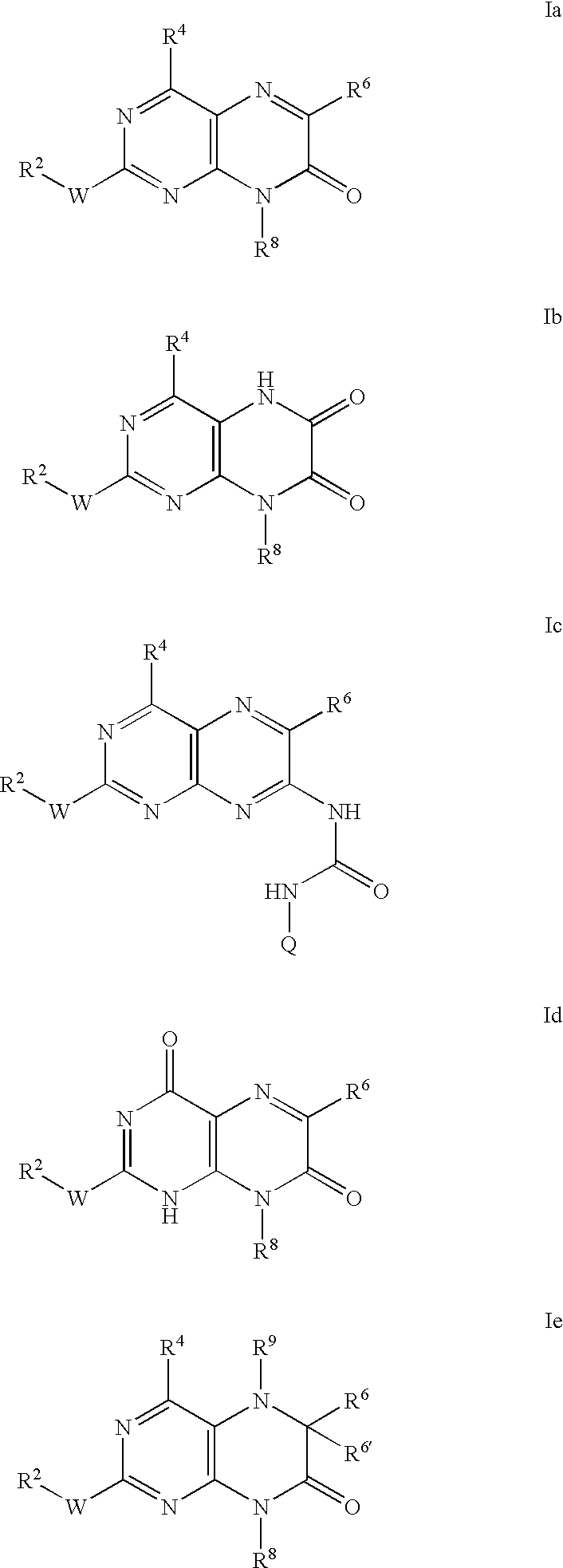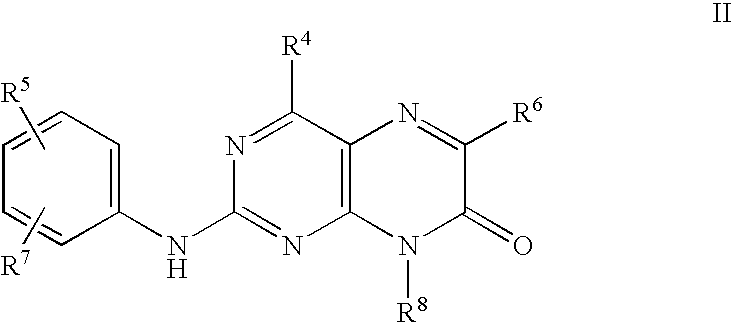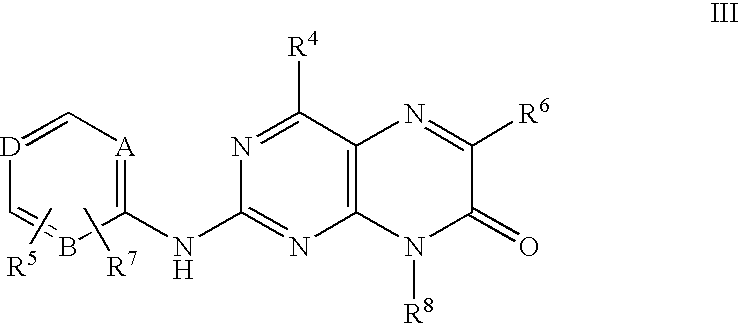Pteridinones as kinase inhibitors
a technology of pteridinones and kinase inhibitors, applied in the field of pteridinones as kinase inhibitors, can solve problems such as human tumors and achieve the effects of reducing the risk of cancer and other proliferative disorders
- Summary
- Abstract
- Description
- Claims
- Application Information
AI Technical Summary
Benefits of technology
Problems solved by technology
Method used
Image
Examples
example 1
Synthesis of 2-Halo-4-(substituted-amino)-5-nitropyrimidines
1. 2-Chloro-4-(methylamino)-5-nitropyrimidine
[0153]
[0154]A solution of 5.82 g (30 mmol) of 2,4-dichloro-5-nitropyrimidine (N. Whittaker, J. Chem. Soc., 1951;1565–1570) in 100 mL of tetrahydrofuran (THF) is cooled to −78° C. and a solution of 4.66 g (60 mmol) of 40% aqueous methylamine in 20 mL of 2-propanol is added dropwise over 5 minutes. After a further 10 minutes at −78° C., the mixture is allowed to warm to room temperature, and the solvent is removed under vacuum. The residue is then extracted into ethyl acetate (EtOAc), washed with water, and dried with sodium sulfate (Na2SO4). Removal of the solvent and chromatography on silica, eluting with hexane / EtOAc (92:8), gives 4.87 g (86%) of the title compound: mp (hexane) 86–87° C. (lit. mp: 90–91° C.; G. B. Barlin, J. Chem. Soc. (B), 1967:954–958).
[0155]1H NMR (CDCl3): δ 9.05 (s, 1H, H-6), 8.40 (br, 1H, exchangeable with D2O, NH), 3.23 (d, J=5.1 Hz, 3H, CH3).
[0156]13C NMR...
example 2
Synthesis of 2-(Substituted-amino)-4-(Substituted-amino)-5-nitropyrimidines
1. 4-(Methylamino)-2-[[4-(morpholin-4-yl)phenyl]amino]-5-nitropyrimidine
[0177]
[0178]To a room temperature solution of 0.943 g (5 mmol) of 2-chloro-4-(methylamino)-5-nitropyrimidine in 25 mL THF is added a solution of 1.96 g (11 mmol) of 4-(4-aminophenyl)morpholine in 100 mL of 2-propanol, and the resulting mixture is heated and stirred at 50° C. for 30 minutes. The mixture is then diluted with water, the solid precipitate is collected, washed with water, and dried, to give 1.62 g (98%) of the title compound: mp (EtOH) 240–241° C.
[0179]1H NMR [(CD3)2SO]: δ 10.24 (br, 1H, exchangeable with D2O, 2NH), 8.93 (s, 1H, H-6), 8.87 (br, 1H, exchangeable with D2O, 4NH), 7.71 (br d, J=8.1 Hz, 2H, H-2′,6′), 6.94 (d, J=8.8 Hz, 2H, H-3′,5′), 3.73 (br t, J=4.7 Hz, 4H, CH2O), 3.07 (br t, J=4.7 Hz, 4H, CH2N), 3.04 (d, J=4.7 Hz, 3H, CH3N).
[0180]Analysis calculated for C15H18N6O3: C, 54.54; H, 5.49; N, 25.44. Found: C, 54.81; H,...
example 3
Synthesis of 2-(Substituted-amino)-4-(substituted-amino-5-aminopyrimidines
1. 5-Amino-4-(methylamino)-2-[[4-(morpholin-4-yl)phenyl]amino]-pyrimidine
[0220]
[0221]Hydrogenation of 4-(methylamino)-2-[(4-morpholinophenyl)amino]-5-nitropyrimidine (from Example 2(1) above) over palladium on charcoal (Pd / C) gave the title compound as a solid.
[0222]1H NMR [(CD3)2SO]: δ 8.22 (br, 1H, exchangeable with D2O, 2NH), 7.61 (d, J=8.9 Hz, 2H, H-2′,6′), 7.33 (s, 1H, H-6), 6.80 (d, J=9.0 Hz, 2H, H-3′,5′), 6.37 (q, J=4.6 Hz, 1H, exchangeable with D2O, 4NH), 3.92 (br, 2H, exchangeable with D2O, NH2), 3.72 (br t, J=4.7 Hz, 4H, CH2O), 2.97 (br t, J=4.7 Hz, 4H, CH2N), 2.89 (d, J=4.5 Hz, 3H, CH3).
2. 5Amino-2-[[4-[2-(diethylamino)ethoxy]phenyl]amino]-4-(methylamino)pyrimidine
[0223]
[0224]Hydrogenation of 2-[[4-[2-(diethylamino)ethoxy]phenyl]amino]-4-(methylamino)-5-nitropyrimidine (from Example 2(2) above) over Pd / C gave the title compound as an oil.
[0225]1H NMR [(CD3)2SO]: δ 8.26 (br, 1H, exchangeable with D2O...
PUM
| Property | Measurement | Unit |
|---|---|---|
| temperatures | aaaaa | aaaaa |
| temperature | aaaaa | aaaaa |
| temperature | aaaaa | aaaaa |
Abstract
Description
Claims
Application Information
 Login to View More
Login to View More - R&D
- Intellectual Property
- Life Sciences
- Materials
- Tech Scout
- Unparalleled Data Quality
- Higher Quality Content
- 60% Fewer Hallucinations
Browse by: Latest US Patents, China's latest patents, Technical Efficacy Thesaurus, Application Domain, Technology Topic, Popular Technical Reports.
© 2025 PatSnap. All rights reserved.Legal|Privacy policy|Modern Slavery Act Transparency Statement|Sitemap|About US| Contact US: help@patsnap.com



